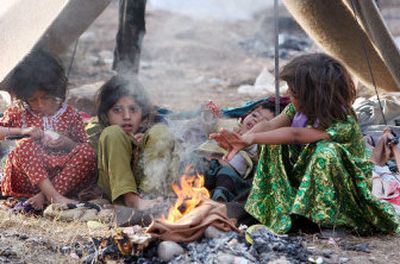Quake survivor: ‘Only with a tent can we survive the winter’

NURPURA, Pakistan – The earthquake left just enough splintered planks and snapped beams in the ruins of Mohammed Azeem Khan’s house for him to cobble together a shack.
He and his wife scavenged a few corrugated metal sheets from the rubble of a nearby school to add a couple of walls and a roof. At night, freezing wind whistles through gaping holes between the timbers of the rickety hut, 3,200 feet up a mountainside.
This is where Khan and his family of six will try to survive waist-deep snow and biting cold in the bitter Himalayan winter. He doesn’t like their chances.
“We’re only covering our heads with this,” he said. “We’re just getting by. Only with a tent can we survive the winter.”
The United Nations warns that thousands of quake victims could die of exposure and cold-related illnesses such as pneumonia unless tents designed to withstand heavy snow and wind arrive soon.
The Oct. 8 earthquake left up to 3.3 million Pakistanis homeless, most of them in the mountains of Kashmir and North-West Frontier Province, where tens of thousands of survivors can be reached only by helicopter.
Pakistan’s government and relief agencies have distributed about 60,000 tents, most of them made of thin cotton or polyester, which are unlikely to keep people warm in the dead of winter.
Pakistan needs at least 200,000 more winter tents to shelter quake survivors, according to the International Organization for Migration, a Geneva-based agency aiding quake victims.
The shortage of winter tents is so severe that the British aid group Oxfam has called on military forces around the world to begin moving tents to Pakistan’s quake zone.
“These tents are currently gathering dust waiting for an emergency,” Nick Roseveare, Oxfam’s humanitarian director, said in a statement. “While this might not be a military emergency, it is an emergency, and those tents are needed to save lives.”
The United States, Canada and other countries have donated surplus winter tents, but so far governments appear unwilling to tap their main military stockpiles, Oxfam said.
“Of course we understand that the military likes to be ready to rush into battle at a moment’s notice, but thousands of people could die unless all of the world’s winter tents are made available,” Roseveare said.
As of Sunday, the U.S. military had donated 534 tents and had plans to give 4,000 more, said Air Force 1st Lt. Tawny Dotson of U.S. Central Command.
Dotson was not certain whether the tents were winterized, describing them as “like a building with pretty thick walls that are waterproof and can be sealed.” They accommodate at least 10 people each, she added.
Anticipating that governments won’t be able to deliver enough suitable tents in time, aid agencies are adding plastic tarps to ordinary tents and giving villagers tools to build temporary shelters, International Organization for Migration spokesman Chris Lom said.
The magnitude 7.6 quake killed an estimated 80,000 people and injured about 70,000 others. The injured continue to stream down from mountain villages searching for medical attention.